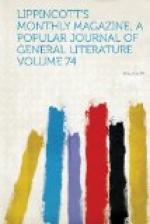Ye Hutte is a misnomer for the extraordinary establishment, studio and domicile combined, at which we dismounted. It is not a hut, and neither in architectural motive nor the artistic proclivities of its inmates has it aught to do with the centuries when our English tongue was otherwise written or spoken than it is to-day. Ye Hutte is a vast, barn-like building, plain and bare save for an inviting vine-grown porch vaguely Gothic in reminiscence, although nondescript in fact. It was erected by some dissenting society for public worship: hence its interior is one immense vaulted room, with cathedral-like windows and choir-gallery across one end. “The body of the house,” to speak ecclesiastically, is cumbered with easels and the usual chaotic impedimenta of painters. The choir, ascended by a ladder, holds three tiny cot-beds, while beneath the choir and concealed by beautiful draperies are stored the domestic and culinary paraphernalia,—pots, pans, brushes, dishes, and, above all, the multiplicity of petroleum- and spirit-stoves in which the Bohemian artistic soul delights. Ye Hutte is an artist’s studio, and its name may be found in all the exhibition catalogues, for several generations of painters drift through it every year. As one inmate rushes off to the Continent, the sea-shore, or the mountains, another takes his place. Yet Ye Hutte holds scant place in its real owner’s esteem compared with that larger studio owned by all the Dean artists in common, where all their summer’s work is done, and which is parquetted with grain-field gold and meadow emerald, walled with rainbow horizons, and roofed with azure festooned with spun silk. Ye Hutte is better appreciated as evening rendezvous for the palette-bearing hosts, both male and female, who, sunbrowned and tired, partake there of restful social converse as well as of the hospitable cup that cheers. Evening after evening, by twos and threes, they sit in the moonlight under the silver-touched vines and dewy blossoms of the porch, listening to the far-away cry of night-birds, the murmur of drowsy bells upon cattle stirring in sleep, or of human voices idealized by remoteness into faint haunting music, while before them white light touches the wooded heights of Cliefden,—distant heights full of picturesque mystery and passionate history,—touches and idealizes into a semblance of poetic realism the sham ruins of Hedsor, and spreads a pearly sheen over the unseen Valley of the Shadow of Light through which winds the quiet Thames.
To the usual artistic circle of Ye Hutte is often added a not uncongenial element from the outside world, sometimes even from within the borders of Philistia. Story-tellers, moved by the subtile magnetism of the artistic creative faculty, whether of brush, chisel, or pen, come up sometimes from London, bringing with them an atmosphere of publishers’ offices, of romance in high and low life, of professional gossip and criticism. Often a stalwart bicyclist rolls up from the capital, bringing with him such a breeze from the world of newspapers, theatres, and crack restaurants that Ye Hutte straightway determines to order some weekly journal, waxes ardent for flesh-pots other than of Cookham, and resolves upon having a Lyceum twice a week when the Dean shall be swept by the blasts and St. John’s Wood studios swallow us up for the winter.




